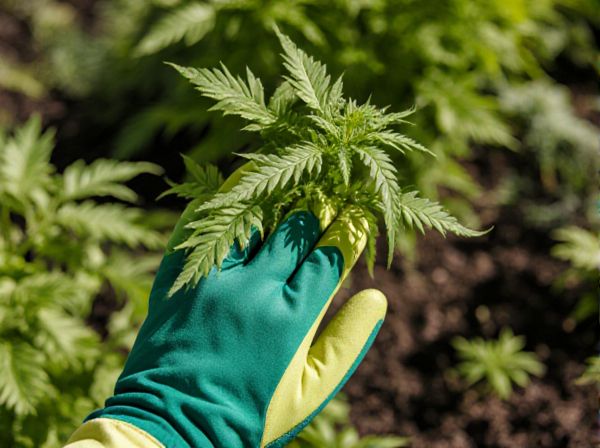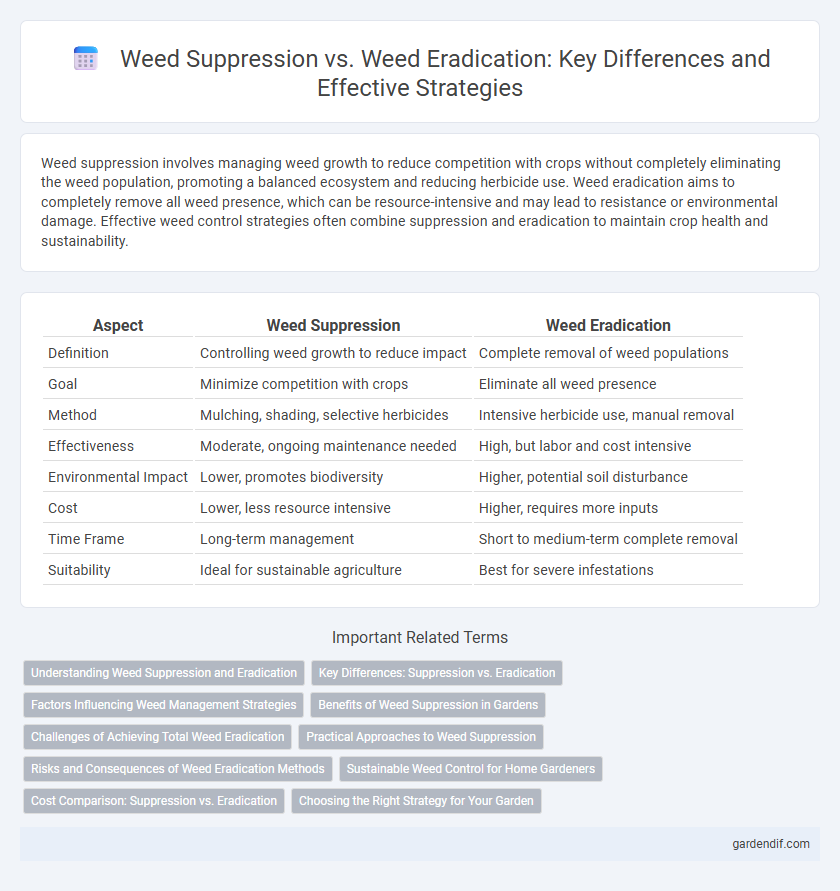
Weed suppression vs weed eradication Illustration
Weed suppression involves managing weed growth to reduce competition with crops without completely eliminating the weed population, promoting a balanced ecosystem and reducing herbicide use. Weed eradication aims to completely remove all weed presence, which can be resource-intensive and may lead to resistance or environmental damage. Effective weed control strategies often combine suppression and eradication to maintain crop health and sustainability.
Table of Comparison
| Aspect | Weed Suppression | Weed Eradication |
|---|---|---|
| Definition | Controlling weed growth to reduce impact | Complete removal of weed populations |
| Goal | Minimize competition with crops | Eliminate all weed presence |
| Method | Mulching, shading, selective herbicides | Intensive herbicide use, manual removal |
| Effectiveness | Moderate, ongoing maintenance needed | High, but labor and cost intensive |
| Environmental Impact | Lower, promotes biodiversity | Higher, potential soil disturbance |
| Cost | Lower, less resource intensive | Higher, requires more inputs |
| Time Frame | Long-term management | Short to medium-term complete removal |
| Suitability | Ideal for sustainable agriculture | Best for severe infestations |
Understanding Weed Suppression and Eradication
Weed suppression involves managing weed growth to minimize competition with crops, using methods like mulching, cover crops, and selective herbicides to keep weed populations under control without complete removal. Weed eradication aims for total elimination of weed species from a specific area, often requiring repeated and intensive interventions such as chemical treatments, mechanical removal, or integrated weed management strategies. Understanding the difference is crucial for selecting appropriate agricultural practices that balance crop productivity and environmental sustainability.
Key Differences: Suppression vs. Eradication
Weed suppression involves controlling the growth and spread of weeds to manageable levels without necessarily eliminating them entirely, while weed eradication aims for complete removal of weed populations from an area. Suppression techniques often include mulching, mowing, and selective herbicides that reduce weed vigor, whereas eradication typically requires intensive methods such as repeated herbicide applications, soil solarization, or mechanical removal to destroy weed seeds and roots. The key difference lies in the objective: suppression focuses on maintaining weed presence below damaging thresholds, whereas eradication seeks total elimination to prevent future weed emergence.
Factors Influencing Weed Management Strategies
Weed management strategies are influenced by factors such as weed species diversity, environmental conditions, and crop tolerance levels. Suppression focuses on reducing weed growth and competition through cultural practices and selective herbicide use, while eradication aims for complete removal via more intensive methods like systemic herbicides or mechanical uprooting. Economic considerations and long-term sustainability goals also determine the choice between suppression and eradication in weed management.
Benefits of Weed Suppression in Gardens
Weed suppression in gardens minimizes competition for nutrients, water, and sunlight, promoting healthier plant growth and higher yields. It reduces the need for harsh chemical herbicides, supporting sustainable and eco-friendly gardening practices. Maintaining a controlled weed presence also encourages biodiversity, which can improve soil health and natural pest control.
Challenges of Achieving Total Weed Eradication
Total weed eradication faces significant challenges due to the resilience and adaptive nature of weed species, which develop resistance to herbicides and environmental stresses. Soil seed banks harbor dormant seeds for years, allowing weeds to reemerge even after intensive control measures. Furthermore, varying growth conditions and diverse weed species complicate the implementation of a single, comprehensive eradication strategy.
Practical Approaches to Weed Suppression
Weed suppression focuses on managing weed growth to reduce competition with crops through practical approaches like mulching, crop rotation, and timely mechanical cultivation. Utilizing cover crops enhances soil health and naturally inhibits weed emergence, promoting sustainable weed control. Integrated weed management combines cultural, mechanical, and biological methods to maintain weed populations below harmful levels without the need for complete eradication.
Risks and Consequences of Weed Eradication Methods
Weed eradication methods often involve aggressive chemical treatments or mechanical removal techniques that can disrupt soil health and non-target plant species, leading to long-term ecological imbalance. The overuse of herbicides in eradication increases the risk of herbicide-resistant weed populations, complicating future management efforts. In contrast, weed suppression techniques minimize environmental risks by maintaining weed populations at manageable levels, reducing the adverse consequences associated with complete eradication.
Sustainable Weed Control for Home Gardeners
Weed suppression focuses on managing weed growth by reducing their impact through mulching, crop rotation, and selective planting, promoting a balanced garden ecosystem without complete removal. Weed eradication aims at completely eliminating weeds through intensive methods such as chemical herbicides or manual removal, which can disrupt soil health and biodiversity. Sustainable weed control for home gardeners emphasizes suppression techniques that enhance soil quality, support beneficial insects, and reduce reliance on harmful chemicals for long-term garden productivity.
Cost Comparison: Suppression vs. Eradication
Weed suppression typically involves ongoing management practices such as mulching, mowing, and the use of herbicides to control weed growth, resulting in lower initial costs but recurring expenses over time. Weed eradication requires more intensive methods like repeated chemical treatments or mechanical removal aimed at completely eliminating weeds, leading to higher upfront costs but potentially reducing long-term financial burdens. Evaluating cost-effectiveness depends on the scale of infestation, type of weed species, and desired land use outcomes.
Choosing the Right Strategy for Your Garden
Choosing the right strategy for weed control depends on the garden's size, weed species, and long-term maintenance goals. Weed suppression focuses on minimizing weed growth through mulching, ground covers, and selective herbicides to maintain soil health and garden aesthetics. Weed eradication involves complete removal via hand-pulling, systemic herbicides, or solarization, providing a long-term solution but requiring more labor and careful monitoring to avoid re-infestation.
Weed suppression vs weed eradication Infographic

 gardendif.com
gardendif.com